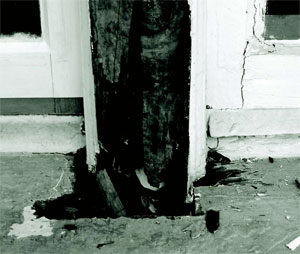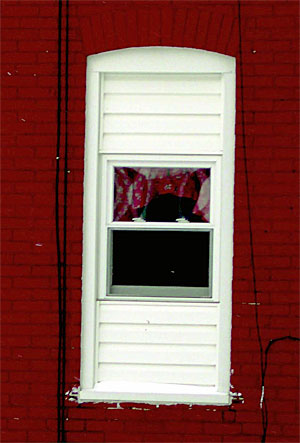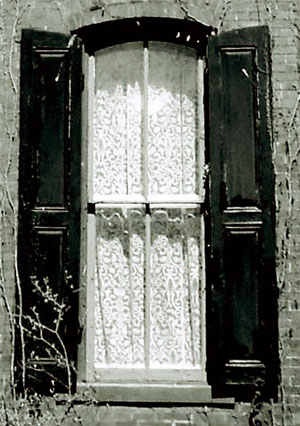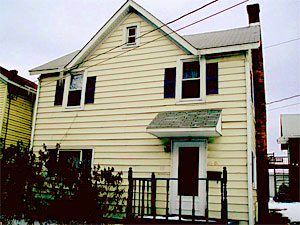Windows
If you are doing any window projects on a house or building inside the historic district, you need to complete the following:
- HARB Application
- Window Replacement Submittal Requirements (if replacing)
- Window Inventory Worksheet (per window)
A lack of information on your project may severely delay the review of your application. Please have all information ready when you are applying. If you have questions about window rehabilitation or replacement, please reach out to HARB Administrator, Gina Thompson, at gthomopson@bellefontepa.gov or 814-355-1501 ext 216.
Window Resources:
- Replacement Windows that Meet the Standards (NPS)
- Why replacing your historic wooden windows is not energy or cost efficient
- National Park Service Preservation Briefs #9: The Repair of Historic Wooden Windows
- Window Preservation Alliance
Download a PDF copy of Bellefonte’s Window Design Guidelines
*** Print copies of these items are available at the Borough offices from HARB Staff.
Bellefonte Window Design Guidelines
Character-Defining Features
One of the most frequently addressed topics Is the repair and replacement of windows. These guidelines were prepared to assist property owners with information when considering the repair or replacement of wood windows. They are not intended to replace consultation with Historical and Architectural Review Board (HARB) staff and other qualified professionals, such as architects or contractors.
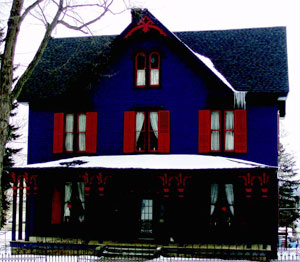
Windows are important character-defining features of historic buildings
Any change to the exterior of a building in the Historic District must be reviewed by HARB. The HARB uses the Secretary of the Interior’s Standards for the Treatment of Historic Properties to review all of its projects. Each application is considered individually for the appropriateness of the project to the building for which it is proposed. Treatments that may be allowable and acceptable in one location may not be appropriate at another.
Windows are important character-defining features of historic buildings. They are the one feature of a building that functions as an integral part of both the exterior and interior. They provide natural light and fresh air to the interior of a building and they allow for views to the outside.
From the outside, they contribute to the rhythm of the building and of the streetscape. Windows help to define a building’s architectural style and its building period. Any changes to windows that are not well planned can negatively affect a building’s appearance and the appearance of the entire streetscape. A street of well-maintained windows adds visual interest. The addition of modern components in the form of new materials or new shapes can contribute to a building and a streetscape that is neither attractive nor desirable. A seemingly small change can have a surprisingly large impact on overall appearance …
The Secretary of the Interior’s Standards
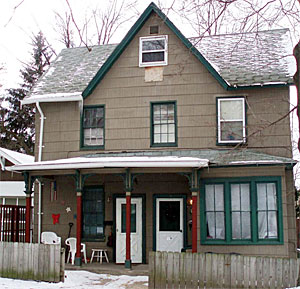
The addition of two vinyl windows and the change in shape of the window in the dormer illustrate how important windows are to the appearance of a property
The Secretary of the Interior’s Standards for Rehabilitation states that “the historic character of a property shall be retained and preserved. The removal of distinctive materials or alteration of features, spaces, and spatial relationships that characterize a property shall be avoided.” They also say that “Distinctive materials, features, finishes, and construction techniques or examples of craftsmanship that characterize a property shall be preserved.” Additionally, they require that “Deteriorated historic features shall be repaired rather than replaced. Where the severity of deterioration requires replacement of a distinctive feature, the new feature shall match the old in design, color, texture, and where possible materials.”
So these standards, used by HARB to evaluate all projects, state that distinctive features should not be removed, that materials should be preserved and most importantly that historic features should be repaired rather than replaced. Because windows are an incredibly important character-defining feature of historic buildings these requirements apply to wood windows and any improvements proposed to them.
So what does the Secretary of the Interior’s Standards mean for property owners with wood windows? They require that windows need to be stabilized to prevent any further deterioration and that they be repaired where necessary. If the condition of a historic window requires it, the window should be replaced with a new window that matches the old in materials (wood) and in design (2/2 windows to replace 2/2 windows, 9/9 windows to replace 9/9 windows), color should be considered also (white vinyl windows are not appropriate on a house that has historically had wood windows painted a dark color). It also means that large or irregularly shaped windows must be replaced with windows of the same size and shape. Openings cannot be blocked in to accommodate stock windows. Nor can stock windows be used to fill an opening when it changes the design of the window. Additionally, window openings should not be enlarged to allow for modern “bay” or “bow” windows. In general, the least amount of change maintains the most accurate historic appearance.
Assessment

Parts of a window
Most property owners only become really aware of their windows when there is a problem. Things like air infiltration, reduced range of operation, maintenance issues and/or poor appearance especially due to failing paint can bring windows to a property owner’s attention. In order to avoid problems before they arise a window assessment it a useful tool.
The first step in any assessment should be to evaluate the architectural and historic significance of the windows. They should be considered significant if:
- they are original to the building;
- reflect the original design intent of the building;
- reflect period or regional building styles or practices;
- reflect changes to the building resulting from major periods or events;
- are examples of exceptional craftsmanship or design.
Once you have ascertained the significance of each window, you need to assess the condition of each window. Every window should be checked for a variety of criteria:
- The condition of the wood and the paint (which protects the wood from the elements) should be evaluated.
- The frames should be examined to be sure they fit closely to the window trim.
- The sash should be examined for putty condition, the tightness of the glass, and the fit of the sash within the frame.
- The sills should be examined inside and out.
- The exterior caulking should be inspected as well.
- Any decorative window trim should be included in the assessment.
Finally, the overall condition of all the windows should be noted. This kind of window inventory will be useful for property owners to help prioritize their projects. The inventory is also necessary for HARB to consider applications for window replacement. HARB staff has a window inventory checklist you may use to assess the condition of your windows.
Maintenance
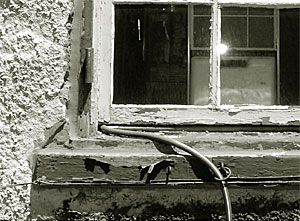
An example of paint failure
Once you have an accurate picture of the significance and condition of each window you can develop a maintenance program to keep windows in good repair. Wood windows need a schedule of maintenance just like a car or a furnace. Minimally, they need to be cleaned, failing paint needs to be removed, and new paint, stain or varnish applied to prevent rot. Window sills that are exposed to the weather more than any other part of the window need to be examined more frequently than other parts of the windows. Repainting, especially on the horizontal members like sills where water can puddle can increase the lifespan of wood windows. Window hardware needs to be maintained. The glazing putty–the clay-like material that holds the glass panes in place within the wood sash–needs to be checked when painting. If it is dried out and separated from the frame it needs to be replaced. Reglazing, recaulking, and new weatherstripping can keep wood windows energy efficient. Window operation can be improved by checking sash cords and weights and removing paint build-up in corners and within the jambs.
Often windows appear to be in worse condition than they actually are. A rotted sill or bottom rail can be repaired without replacing an entire window. When deteriorated parts are found they can be stabilized. At the early stages of wood decomposition, in-place treatments like insect treating, fungus treating, epoxy consolidation, puttying holes and cracks are viable options. This kind of treatment can provide a sound window, an appropriate appearance, and a long life to an existing window. Remember that fungicides and wood preservatives can be toxic especially to children and animals so be sure to follow the manufacturer’s instructions.
A regular routine of maintenance for wood windows can prevent the need for more costly rehabilitation and repair. Still, windows do deteriorate and do require more than routine maintenance. So the next thing to consider is a hierarchy of repair.
Repair
Those windows with the most deterioration would obviously be highest on the list for repair. When a component is too deteriorated to be stabilized it may be repaired in kind. Splicing new wood into the existing members is an appropriate treatment in most cases. A woodworker or carpenter familiar with wood window repair can give you estimates for parts and labor. Repair is labor-intensive but a historic wood window can be repaired by a contractor for about the same cost as a lower-quality replacement window.
Many millwork firms can duplicate parts for wood windows, such as muntins, bottom rails, or sills. You may need to look to find the best firm for the job because some mills dislike repairing old windows because nails or other objects that can damage their cutting knives. Some do not have the correct knives to duplicate the necessary profiles. If you cannot find a firm locally to do your job, there are firms that will do this kind of repair and ship nationwide. It is also possible for an advanced do-it-yourselfer to duplicate simple moulding profiles if desired.
Issues such as lead abatement will increase the cost of working with historic wood windows but there are safe effective methods to deal with lead paint. For more information on this subject please see Preservation Brief #37 available at the National Park Service website.
Replacement In-Kind
As a last resort, an entire window may be replaced if the individual parts cannot be repaired or if the repair of all the deteriorated parts equals in effect an entire window replacement. When seeking a replacement window be sure to match the material, size, shape, operation, muntin pattern, profile, and detailing of the historic window. The decision to replace windows within the HARB district should be made only after consultation with HARB staff. If it is determined that a window replacement is necessary, the process of selecting the replacement must begin by understanding the windows that are being replaced: their size, shape, materials, location on the building needs to be considered. The decision to replace windows should NOT begin with a trip to the local home improvement center or building supply store. Only after determining how the window contributes to the building, the proportions of frame, sash, glass (daylight opening), the configuration of the panes, and other details such as muntin and molding profiles, decorative details and paint color can an appropriate replacement that retains as much of the historic character as possible be found.
Consider moving better windows from a less-visible part of the house to the main façade and using replacements on the less-visible elevations. Many reputable window companies make quality wood windows that can be appropriate for replacements, especially if you need to replace a lot of windows. An option to consider when you need to replace only a few windows is to have the new window constructed by a local carpenter who is well-versed in repair/replacement of wood windows. When replacing a window there should be no reduction of the daylight opening, meaning the new sash should not be wider than the old sash and the area of glass should be the same as in the original window. Snap-in muntins or those that are sandwich between two layers of glass do not convey the same sense of historicity as true divided light windows and are not recommended.
Historic Materials: Storm Windows and Energy Efficiency
When dealing with historic buildings, windows are often a contentious item. A property owner is torn between the need to retain the historic character of the windows and the competing desire to improve energy efficiency and reduce window maintenance. Replacement sash or total replacement is often suggested in order to promote energy efficiency, reduce long-term maintenance costs, window longevity, and provide better window operation.
Studies have indicated that only about twenty percent of the heating loss from a building is through the windows.
The remaining eighty percent is through the roof, walls, floors, and chimneys, with roofs having the greatest percentage of heat loss. Reducing heat loss through windows by fifty percent will only reduce total heat loss by ten percent. The cost of replacement windows is often substantial and the actual energy savings are often not significant.
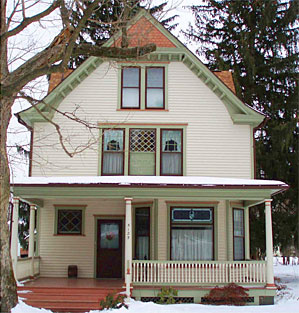
Can you see the storm windows on this building? Good storm windows will be almost invisible when installed properly.
A study funded by the Vermont State Historic Preservation office tested the assumption that historic windows can be retained and upgraded to approximate the thermal efficiency of replacement sash or window inserts. That study found that interior storm windows reduced exterior air infiltration and sash air infiltration and exterior storm windows in good condition all reduced sash infiltration when they were closed. Replacement of a historic wood window does not necessarily result in greater energy savings over upgrading the existing window. Studies conducted by the Historic Landmarks Foundation of Indiana had similar findings, that effective window rehabilitation can be accomplished at a lower cost than replacement of windows while still resulting in significant energy savings.
Some ways that are recommended to reduce air infiltration around windows without replacement include:
- weatherstripping between all moving part;
- replacing broken glass;
- re-caulking perimeter joints;
- removing and replacing missing or dried glazing putty;
- adding sash locks to tighten windows; adding interior or exterior storm windows (which can achieve similar R-values to new thermal windows);
- and insulating.
Air lost between the frame and the rough opening can be significant and is often overlooked. Check behind the window trim for air leakage and heat loss then insulate this area if necessary. Other ways to reduce heat loss can include installing blinds and curtains to prevent the movement of air. There are also temporary weatherproofing methods that a homeowner can use while exploring the cost of more permanent solutions. Clear plastic sheeting kits, sold for the purpose of weatherproofing, are easy for two people to install. The plastic is clear allowing light through and it is easy to remove and reapply.
None of these temporary measures is as effective as a wood window in good repair, along with a good quality storm window. This combination is nearly as efficient as a double-glazed insulated replacement window. However, storm windows can be clumsy looking, especially older aluminum storm windows. There are newer, more attractive, easier-to-use storm windows on the market today. A number of reputable companies can make exterior metal storm windows that are appropriate for historic windows, matching shape, color, muntin pattern and other requirements. These higher-quality windows cost a bit more but they will also be more sturdily constructed, easier to operate, and better insulated. They also come in a wider variety of colors which are more appropriate for historic buildings than the standard bright white. Wood storm windows can also be custom made to fit any size opening and allow less heat loss through the frame than aluminum storm windows.
the shape of the opening and align the division of the storm window to match the divisions in the window. Allowing as much of the historic window to be visible as possible is also important. Stock storm units are discouraged and units that require infill panels are not acceptable.
Minimize damage to wood windows and trim when installing storm windows. Never fasten storm windows into decorative trim. Maintain your storm windows according to the manufacturer’s instructions including caulking and weatherstripping. Make sure to allow for exterior drainage at the sill. Removable storm sash will facilitate the maintenance of historic windows.
Modern Materials: Maintenance, Energy Efficiency, and Lifespan
Many times property owners are encouraged to replace windows because modern windows are more energy-efficient and require less maintenance. Owners often believe that replacing windows will save them time and money. The bottom line is that all windows require maintenance. A wood window requires upkeep and maintenance to keep it functioning properly. A properly maintained wood window can last for hundreds of years. Components can be replaced individually as necessary. A modern replacement window is often not repairable. The entire unit must be replaced. Additionally, modern replacement units have a fixed life expectancy after which the entire unit must be replaced.
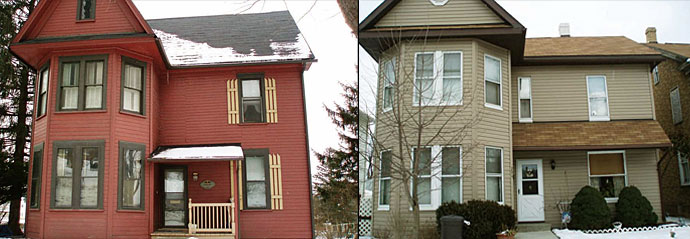
These two homes are similar in size, shape, and window configuration. Note that the house on the right has installed vinyl windows and changed the shape of the window in the gable as well as on the first floor.
Glass is preferable in these windows as plexiglass can discolor and alligator.
Interior storm windows are another option and they minimize the change to the exterior of the building. Replacement windows have a reported lifespan of between fifteen and thirty years. So, a window with a fifteen-year life span will need to be replaced every fifteen years in order to maintain its energy efficiency. Insulated or double-glazed windows have an inner and outer pane of glass with a sealed air space in between. The air space is usually filled with argon gas and has a perimeter seal. This perimeter seal can fail, leading to a loss of insulation. These double-glazed windows are a “closed” system meaning that each sash is manufactured as a single unit and the failure of any part of that unit can signal the failure of the entire unit. The reported actual seal life of lower-quality vinyl windows is somewhere between six and ten years. As joints and seals deteriorate, openings form that allow air and water to enter into the window frame, wall cavity, and sometimes the building interior, causing damage. Repair of these broken seals requires another replacement. Also, if a double-glazed window has cracked or broken glass, it requires replacement of the part with a new manufacturer part. If a manufacturer has changed its designs or gone out of business then a matching replacement will not be available. By comparison, wood windows can be in use for 100 to 200 years after their initial construction. Wood windows last far longer than any modern product with minimal scheduled maintenance and judicious repairs. A carpenter or a competent homeowner can usually repair a historic wood window with single-pane glazing.
Non-wood window replacements usually differ in their proportions and dimensions from historic wood windows. The width of the sash, muntins, and rails is visibly different as is the color. Generally, vinyl replacement windows are available only in lighter colors because dark-colored vinyl can degrade in sunlight. Nineteenth-century houses, such as those in the Bellefonte HARB regulated district, often had dark window sash. For these reasons, vinyl windows are generally considered unacceptable in historic houses because of their appearance.
Good quality wood windows are a better investment when looking at replacement. Review the various grades available because a better quality window will cost more, but it will also last longer. Understand the limits of new window warranties both for all the parts and for associated labor. Select a reputable manufacturer and installer who is likely to remain in business and be available if problems arise. When considering replacement windows, factor in the cost to remove and dispose of the old windows as well as the purchase price of the new windows. Be sure to add in the cost of installation. Consider also the life-cycle costs associated with more frequent replacement of deteriorated components. Finally, think about your community: the materials and labor used in wood window restoration are generally local which means that the money stays in the community, which is often not the case when replacing with synthetic materials.
Items related to Windows — Shutters and Awnings
Shutters
Historically, shutters were used to protect windows from the elements. They were fully functional, operational wood shutters that closed over the glass. Today, shutters are primarily decorative but they should appear as if they function. Each shutter should be scaled to cover one-half of the entire window when closed. They should be the same height as the window opening within the frame. Shutters should be attached to the window frame and not to the siding. Shutters should not be used on buildings where they were not used historically. False, or synthetic shutters are not recommended, including aluminum and vinyl shutters. Wood shutters are available from reputable dealers or they can be fashioned by a local carpenter.
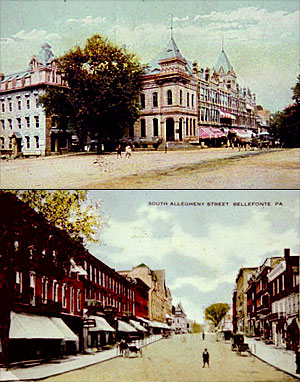
The historic purpose of an awning is similar to its modern function–they shade windows. Historically awnings were either fixed or operable (roll-out), usually made of canvas and supported by a metal frame. Storefront awnings in Bellefonte were often striped as shown in the accompanying historic photos. Sloped awnings are more accurate for historic building than bubble or rounded awnings, historically the sloped awning was used even on arched windows. Modern fixed awnings made of metal or plastic are not acceptable choices in the HARB regulated historic district. Modern fabrics that both stand up well to the weather and have a historically accurate appearance are recommended.
Attachments of awning framework should cause no permanent damage to the structure. Generally, HARB requires that all framework be installed in the mortar joints of masonry building. Once installed awnings should not obscure historical detail and they should not cover too much of the window.
For more information about awnings please see Preservation Brief 44 or Add Shading Devices, available at the National Park Service website.
In conclusion
Historic wood windows are important character-defining features of properties within the HARB regulated district. The Historical and Architectural Review Board is required to follow the Secretary of the Interior’s Standards for Rehabilitation in making all of its decisions about proposed changes. These Standards state that substantial changes to a property be avoided, that windows must be repaired when repair is possible, and that any replacements need to match the original in “design, color, texture, and where possible materials.” Property owners who wish to make changes to their windows need to do a complete window assessment to be sure that the project they are proposing will be appropriate for the building. They are encouraged to contact the Historic Preservation Consultant at 355-1501 before finalizing any plans and before making any deposits. Any expense undertaken before Borough Council approves a project is done at the property owner’s risk and HARB and Council are not liable for those expenses should a project need to be modified.
For more information on repairing historic wood windows please go to the National Park Service website.
Print copies of these items are available at the Borough offices from HARB Staff.
The Certified Local Government Program in Bellefonte receives Federal financial assistance for identification and protection of historic properties. Under Title VI of the Civil Rights Act of 1964, Section 504 of the Rehabilitation Act of 1973, and the Age Discrimination Act of 1975, as amended, the U.S. Department of the Interior prohibits discrimination on the basis of race, color, national origin, disability or age in its federally assisted programs. If you believe you have been discriminated against in any program, activity, or facility as described above, or if you desire further information please write to: Office of Equal Opportunity, National Park Service, 1849 C Street, NW, Washington, DC 20240. This publication has been financed in part with Federal funds from the National Park Service, U.S. Department of the Interior. However, the contents and opinions do not necessarily reflect the views or policies of the Department of the Interior, nor does the mention of trade names or commercial products constitute endorsement or recommendation by the Department of the Interior. No liability is assumed by the creators, authors and/or Bellefonte Borough in regards to the information contained herein. It is presented for information purposes only.

